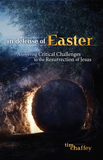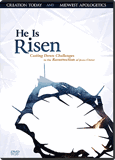
The Resurrection of Jesus Christ: An Introduction
Tim Chaffey, AiG–US, opens a new web series on the Resurrection by examining the importance of this miraculous event.
I enthusiastically look forward to Easter each year since I often have opportunities to speak on the most exciting topic I know—the Resurrection of Jesus Christ. I also love singing the classic hymns about the Crucifixion and Resurrection. Of course, I enjoy writing and speaking about creation, evolution, Genesis, the age of the earth, biblical authority, and the biblical worldview. Still, no topic thrills me as much as thinking about that glorious Sunday morning when an angel rolled the stone away and the death-conquering Savior exited the tomb that had housed His dead body for a short while—since this miracle secured the hope of our salvation.
I try to think about what it must have been like to be in the disciples’ sandals when they saw the risen Savior for the first time. Imagine having all your hopes and dreams dashed to pieces as the person you put your faith in was mercilessly beaten and then brutally executed upon the Cross. The agony and despair felt by the disciples during that time is nearly impossible to fathom. They had left everything for Jesus, and now He was gone, leaving the disciples to wallow in their sorrow, confusion, and shame for following a pretender Messiah who was now viewed as someone accursed by God (Isaiah 53:4; Galatians 3:13).
Picture yourself in Peter’s position. The brash and outspoken disciple who said he would die for Jesus was suffering the depths of despondency, having cowardly rejected Jesus multiple times. Suddenly, Mary Magdalene shows up and says that the body of Jesus is missing and none of the women who went to the tomb that morning know where it is (John 20:2). Did a flash of hope pierce Peter’s mind at that moment? Did anger flow through him as he pondered even more embarrassment at the thought of the Lord’s body being dishonorably treated? What did he think when he entered the tomb and saw the linen cloths lying where the Lord’s body had recently been? Did he plunge deeper into misery as he walked home that morning (John 20:10)?
Peter’s utter hopelessness was finally shattered later that day when Jesus appeared to him alive and well (Luke 24:34; 1 Corinthians 15:5). But this was no fluke appearance—it was not a vision or hallucination. Jesus had already appeared to Mary Magdalene (John 20:11–18), and later that day to two disciples on the road to Emmaus (Luke 24:15), and then to the whole group of disciples minus Thomas (Luke 24:36). Over the next several weeks, Jesus showed Himself alive by “many infallible proofs” to the disciples (Acts 1:3), and on one occasion He appeared to over 500 people at once (1 Corinthians 15:6).
A short while later, the disciples, filled by the Holy Spirit and the knowledge of the risen Savior, went forth in absolute confidence that their message was true and turned the world upside down with the gospel, unwaveringly facing persecution and death along the way.
At the heart of their message was the Resurrection. Peter’s sermon on the Day of Pentecost centered on the Resurrection of Jesus (Acts 2:24–36). Paul focused on the Resurrection as well. Some of the philosophers in Athens thought he was strange because he preached about Jesus and the Resurrection (Acts 17:18). When given an opportunity to speak at the Areopagus, Paul delivered his message and then said that God had given “assurance of this to all by raising [Jesus] from the dead” (Acts 17:31). In fact, Acts covers 12 major addresses as the gospel message spread from Jerusalem to the rest of the Roman Empire, and according to Merrill C. Tenney, “In each stage of presentation the place of the resurrection is constant; it is never deprecated or ignored but occupies a prominent place.”1
Sadly, it seems that this event no longer enjoys a prominent place for many Christians, often being relegated to the topic of the sermon only on Easter Sunday. And I’ve even been to churches where it doesn’t even get that much attention. Some focus so much on the Crucifixion and what Jesus accomplished there that the Resurrection is treated like an afterthought.2 Please don’t misunderstand me. The Crucifixion is absolutely essential, and we must never shy away from discussing the Cross, but the Resurrection is the flip-side of that coin. Without the Resurrection, Christ’s death would be the end of our hopes, and of course, without the Crucifixion, Jesus could not have risen from the dead. Both are necessary for the forgiveness of sins (Ephesians 1:7; 1 Corinthians 15:17).3 In fact, Paul told the Corinthians that the gospel he preached was “that Christ died for our sins according to the Scriptures, and that He was buried, and that He rose again the third day according to the Scriptures,” and that He was seen by numerous people (1 Corinthians 15:1–8).
For the past few years as I have read through the New Testament, I have paid special attention to the Resurrection and have been amazed at just how frequently the writers mention the topic. Paul devoted an entire chapter to the subject and discussed its significance to the Christian faith.
And if Christ is not risen, then our preaching is empty and your faith is also empty. Yes, and we are found false witnesses of God, because we have testified of God that He raised up Christ, whom He did not raise up—if in fact the dead do not rise. For if the dead do not rise, then Christ is not risen. And if Christ is not risen, your faith is futile; you are still in your sins! Then also those who have fallen asleep in Christ have perished. If in this life only we have hope in Christ, we are of all men the most pitiable. (1 Corinthians 15:14–19)
If Jesus did not rise from the dead, then Christianity would be a false religion, we would have no hope, our loved ones would be gone for good, and we would still be in our sins. I appreciate Philip Schaff’s summary on the importance of the Resurrection based on Paul’s words.
The Christian church rests on the resurrection of its Founder. Without this fact the church could never have been born, or if born, it would soon have died a natural death. The miracle of the resurrection and the existence of Christianity are so closely connected that they must stand or fall together. If Christ was raised from the dead, then all his other miracles are sure, and our faith is impregnable; if he was not raised, he died in vain and our faith is vain. It was only his resurrection that made his death available for our atonement, justification and salvation; without the resurrection, his death would be the grave of our hopes; we should be still unredeemed and under the power of our sins. A gospel of a dead Saviour would be a contradiction and wretched delusion. This is the reasoning of St. Paul, and its force is irresistible.
The resurrection of Christ is therefore emphatically a test question upon which depends the truth or falsehood of the Christian religion. It is either the greatest miracle or the greatest delusion which history records.4
Now consider the alternative. If Jesus actually rose from the dead, then an astonishing miracle was performed and through this act God placed His seal of approval on the life and work of Jesus for all to see.5 In other words, the Resurrection shows us that God affirmed the truth of Christ’s teachings, meaning that Jesus is exactly who He claimed to be—the eternal Son of God in human flesh and the Savior of the world. He is the only one who can save us from sin, and the only way to the Father (John 14:6). All who reject Him are doomed to suffer eternally for despising the Lord of life and His offer of forgiveness.
Everything hinges on the Resurrection. If Jesus rose, He is the Son of God and Christianity is true. Consequently, critics and skeptics have tried desperately to develop alternative theories to explain away the Resurrection. In their vain search for a legitimate alternative, they have demonstrated that they understand the centrality of the Resurrection better than some Christians, or at least that they are more concerned about it. Ironically, as will be demonstrated in future articles in this series, the critical and skeptical arguments have actually strengthened our confidence in the truth of the Resurrection.
In the coming weeks, we will embark on a study of the historicity of the Resurrection of Jesus Christ. The next article will describe what the Bible calls “infallible proofs,” essentially surveying the post-Resurrection appearances. The ensuing installment will address several evidences stated in the biblical accounts or derived from them. After that, we will spend several weeks examining the numerous alternative views proposed by skeptics and critics throughout the centuries. By the time we complete our study, you will see that in nearly 2,000 years, not one alternate theory can stand up to scrutiny or come close to accounting for the facts.
The apostles knew that Jesus died on the Cross, and just a few days later, they saw him alive again. They were so sure of this fact that they were willing to face persecution, exile, and death. Imagine having a confidence in the Resurrection similar to the apostles. What would it do to your Christian walk if you had complete assurance of this event? Would you be more motivated than ever to study His Word, spend time in prayer, fellowship with His people, and share the gospel with others?
Christ’s Crucifixion, burial, and Resurrection is the only means by which people can be forgiven of their sins and our only hope for eternal life.
Footnotes
- Merrill C. Tenney, The Reality of the Resurrection (Chicago, IL: Moody Press, 1972), n.p. Electronic version of the chapter in which this statement appears is available from www.rediscoveringthebible.com/Realitych3.pdf. Accessed February 1, 2013.
- I call this the Passion Syndrome, so named for the formula followed in Mel Gibson’s film, The Passion of the Christ. The movie spent most of its two-plus hours illustrating the horrors of Christ’s torture and death, but just over one minute on the Resurrection at the end of the film. Catholics and Protestants often have different reasons for focusing on the Crucifixion, but such a study is beyond the scope of this article. My only point here is that both have neglected the Resurrection at times.
- Mathewson wrote, “[I]n 1 Corinthians 15:17 Paul makes it clear that we are still in our sins if Christ has not been raised. So while the death and resurrection of Jesus Christ were separate events, they are inseparable elements when it comes to providing forgiveness for our sins.” Steven Mathewson, Risen: 50 Reasons Why the Resurrection Changed Everything (Grand Rapids, MI: Baker Books, 2013), p. 23.
- Philip Schaff and David Schley Schaff, History of the Christian Church (New York: Charles Scribner’s Sons, 1910), I.2.19.
- Gary R. Habermas and Michael R. Licona, The Case for the Resurrection of Jesus (Grand Rapids, MI: Kregel Publications, 2004), p. 183.
Recommended Resources

Answers in Genesis is an apologetics ministry, dedicated to helping Christians defend their faith and proclaim the good news of Jesus Christ.
- Customer Service 800.778.3390
- © 2024 Answers in Genesis









